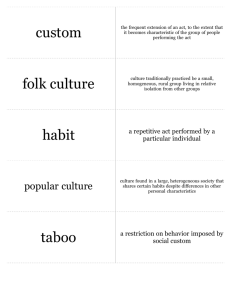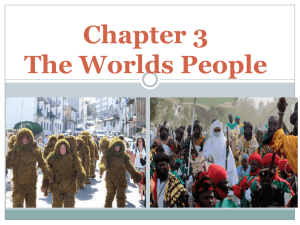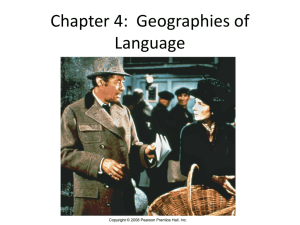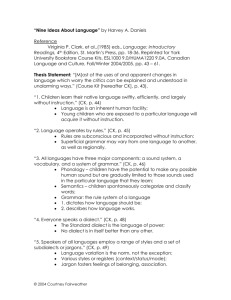Statistical Exploration Geographical Lexical Variation Social Media
advertisement
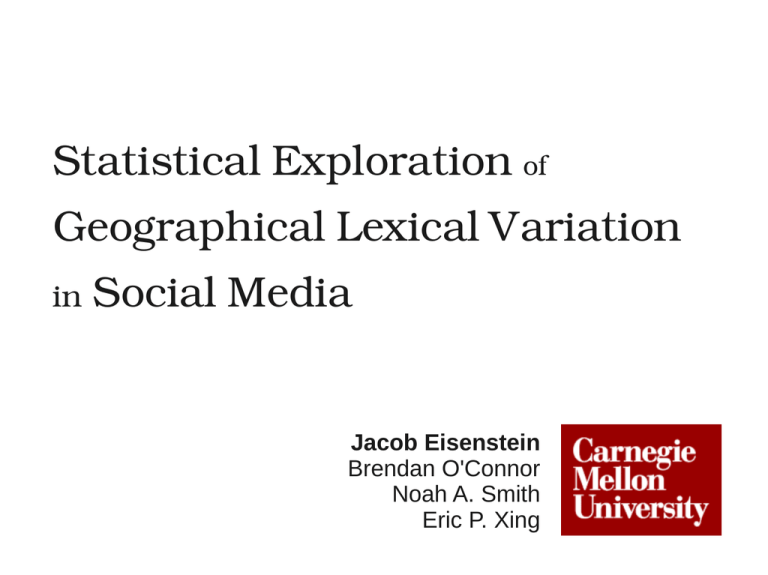
Statistical Exploration of Geographical Lexical Variation in Social Media Jacob Eisenstein Brendan O'Connor Noah A. Smith Eric P. Xing Social media ● ● Social media links online text with social networks. Increasingly ubiquitous form of social interaction ● Social media text is often conversational and informal. Is there geographical variation in social media? Searching for dialect in social media ● One approach: search for known variable alternations, e.g. you / yinz / yall (Kurath 1949, …, Boberg 2005) ● Known variables like “yinz” don't appear much ● Are there new variables we don't know about? Variables and dialect regions ● ● ● Given the dialect regions, we could use hypothesis testing to find variables. Given the variables, we could use clustering to find the regions. Can we infer both the regions and the variables from raw data? Nerbonne, 2005 Outline data model results Data Combines microblogs and social network. ● ● ● Messages limited to 140 characters. 65 million “tweets” per day, mostly public 190 million users ● Diverse age, gender, and racial diversity A partial taxonomy of Twitter messages Official announcements Business advertising Links to blog and web content Celebrity self-promotion Status messages Group conversation Personal conversation Geotagged text ● ● Popular cellphone clients for Twitter encode GPS location. We screen our dataset to include only geotagged messages sent from iPhone or Blackberry clients. Our corpus ● ● ● We receive a stream that included 15% of all public messages. During the first week of March 2010, we include all authors who: ● ≥ 20 geotagged messages in our stream ● From the continental USA ● Social connections with fewer than 1000 users Quick and dirty! ● Author location = GPS of first post Corpus statistics ● 9500 authors ● 380,000 messages ● 4.7 million tokens ● Highly informal and conversational ● ● 25% of the 5000 most common terms are not in the dictionary. More than half of all messages mention another user. Online at: http://www.ark.cs.cmu.edu/GeoText Outline data model results Generative models ● ● How to simultaneously discover dialect regions and the words that characterize them? Probabilistic generative models ● a.k.a. graphical models ● Examples: – – – Hidden markov model Naïve Bayes Topic Models a.k.a. Latent Dirichlet Allocation (Blei et al., 2003) Generative models in 30 seconds ● We hypothesize that text is the output of a stochastic process. For example: Pick some things to talk about Gym, tanning, laundry For each word, pick one thing to talk about pick a word associated with that thing gym “Triceps!” Generative models in 30 seconds ● ● We only see the output of the generative process. Through statistical inference over large amounts of data, we make educated guesses about the hidden variables. Gym, tanning, laundry gym “Triceps!” A generative model of lexical geographic variation For each author Pick a region from P(r | ϑ) η w #words Pick a location from P(y | Λr , νr ) For each token Pick a word from P(w | ηr ) r y #authors ϑ Λ ν #regions A generative model of lexical geographic variation η w #words r y #authors ϑ Λ ν #regions ν and Λ define the location and extent of dialect regions A generative model of lexical geographic variation η w #words r ϑ Λ ν and Λ define the location and extent of dialect regions η defines the words associated with each region y #authors ν #regions Topic models for lexical variation ● Discourse topic is a confound for lexical variation. ● Solution: model topical and regional variation jointly ● Each author's text is shaped by both dialect region and topic ● Each dialect region contains a unique version of each topic “Food” San Francisco Delicious Snack Sprouts Avocados Dinner Delicious Snack Tasty Pittsburgh Dinner Pierogie Primanti's Tasty See our EMNLP 2010 paper for more details Outline data model results Does it work? Task: predict author location from raw text METHOD Mean location Text regression Generative, no topics Generative, topics MEAN MEDIAN ERROR (KM) ERROR (KM) 1148 1018 948 712 947 644 900 494 Induced dialect regions ● Each point is an individual in our dataset ● Symbols and colors indicate latent region membership Observations ● Many sources of geographical variation ● Geographically-specific proper names boston, knicks (NY), bieber (Lake Eerie) ● Topics of local prominence: tacos (LA), cab (NY) ● Foreign-language words pues (San Francisco), papi (LA) ● Geographically distinctive “slang” terms hella (San Francisco; Bucholtz et al., 2007) fasho (LA), suttin (NY) coo (LA) / koo (San Francisco) Discovering alternations soda / pop / coke ● Criteria: ● ● Geographically distinct Syntactically and (hopefully) semantically equivalent Maximize divergence of P(Region | Word) Minimize divergence of P(Neighbors | Word) Examples Summary (1) ● We can mine raw text to learn about lexical variation: ● Discover geographic language communities and geographically-coherent sets of terms ● Disentangle geographical and topical variation ● Predict author location from text alone http://www.ark.cs.cmu.edu/GeoText Summary (2) ● Social media text contains a variety of lexical dialect markers ● ● ● Some are known to relate to speech: e.g., hella Others appear to be unique to computer-mediated communication: coo/koo, lmao/ctfu, you/u/uu, … Future work: systematic analysis of the relationship between dialect in spoken language and social media text Thx!! R uu gna ask me suttin? ϴ α z σ2 Adding topics μ For each author Pick a region from P(r | ϑ) η w #words #topics r ϑ Λ Pick a location from P(y | Λr , νr ) Pick a distribution over topics from P(ϴ | α) For each token Pick a topic from P(z | ϴ ) Pick a word from P(w | ηr,z ) y #authors ν #regions Results METHOD MEAN MEDIAN ERROR (KM) ERROR (KM) Mean location 1148 1018 K-nearest neighbors 1077 853 Text regression 948 712 Supervised LDA 1055 728 Mixture of unigrams 947 644 Geographic Topic Model 900 494 Wilcoxon-Mann-Whitney: p < .01 Analysis


